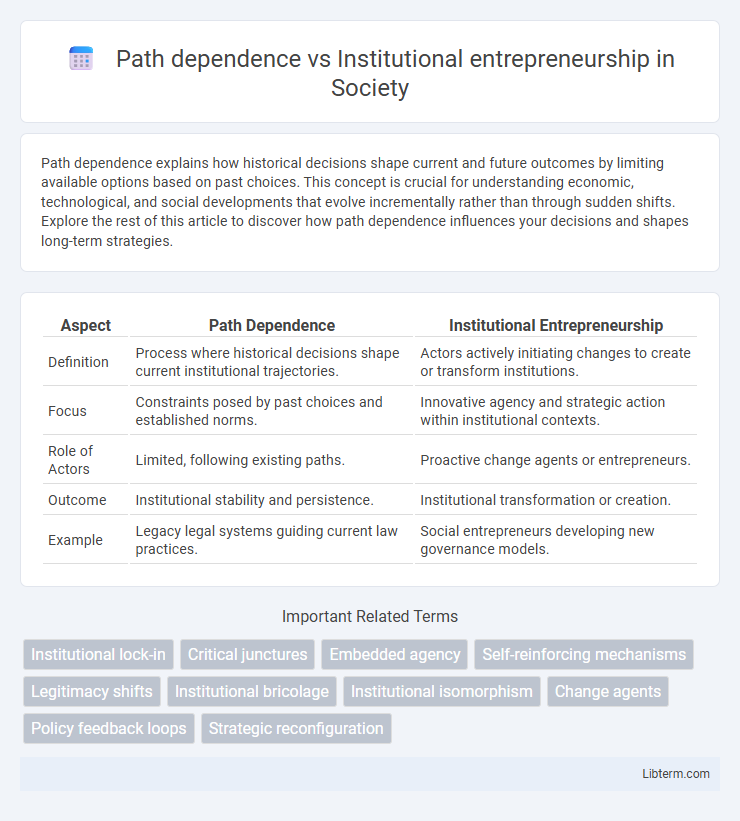Path dependence explains how historical decisions shape current and future outcomes by limiting available options based on past choices. This concept is crucial for understanding economic, technological, and social developments that evolve incrementally rather than through sudden shifts. Explore the rest of this article to discover how path dependence influences your decisions and shapes long-term strategies.
Table of Comparison
| Aspect | Path Dependence | Institutional Entrepreneurship |
|---|---|---|
| Definition | Process where historical decisions shape current institutional trajectories. | Actors actively initiating changes to create or transform institutions. |
| Focus | Constraints posed by past choices and established norms. | Innovative agency and strategic action within institutional contexts. |
| Role of Actors | Limited, following existing paths. | Proactive change agents or entrepreneurs. |
| Outcome | Institutional stability and persistence. | Institutional transformation or creation. |
| Example | Legacy legal systems guiding current law practices. | Social entrepreneurs developing new governance models. |
Understanding Path Dependence: Concept and Implications
Path dependence explains how historical choices and established practices shape current institutional frameworks, leading to constraints on innovation and change over time. Path-dependent processes reinforce specific trajectories through increasing returns, self-reinforcement, and coordination effects, making deviation costly and unlikely. Understanding path dependence is crucial for analyzing institutional inertia and the challenges faced by institutional entrepreneurs aiming to initiate transformative change.
Defining Institutional Entrepreneurship: Agents of Change
Institutional entrepreneurship refers to individuals or groups who leverage their resources and influence to create, transform, or disrupt existing institutional norms and structures. These agents of change actively challenge path dependence by introducing innovative practices that reshape organizational fields or industries. Their strategic actions foster institutional evolution, overcoming entrenched routines to drive long-term social and economic transformation.
Historical Roots: How Path Dependence Shapes Institutions
Path dependence emphasizes how initial historical choices create self-reinforcing mechanisms that shape institutional development over time, limiting future change and guiding organizational behavior. Institutional entrepreneurship challenges path-dependent constraints by enabling actors to strategically disrupt entrenched practices and introduce novel institutional arrangements. Historical roots reveal that deeply embedded institutional frameworks often result from cumulative processes, making innovation contingent on agents' capacity to mobilize resources and legitimize new norms.
Institutional Inertia: Barriers to Innovation
Institutional inertia represents a key barrier to innovation by reinforcing established norms, routines, and power structures that resist change despite evolving environmental demands. Path dependence further entrenches this inertia as historical decisions create self-reinforcing mechanisms limiting alternatives, making transformative institutional entrepreneurship difficult yet critical for overcoming these constraints. Institutional entrepreneurs must navigate and strategically disrupt these rigid frameworks to foster innovative organizational or systemic change.
The Role of Actors in Institutional Entrepreneurship
Actors in institutional entrepreneurship play a crucial role by leveraging their agency to challenge and transform established path-dependent institutional frameworks, often disrupting existing norms and routines. These entrepreneurs mobilize resources, create coalitions, and enact strategic actions that enable institutional change despite embedded constraints from historical trajectories. Understanding the dynamic interplay between actor agency and structural path dependence is essential for analyzing how new institutional arrangements emerge and evolve.
Breaking the Cycle: Strategies to Overcome Path Dependence
Breaking the cycle of path dependence requires leveraging institutional entrepreneurship to introduce innovative practices that challenge entrenched norms and rigid structures. Strategies such as fostering collaborative networks, mobilizing resources for transformative initiatives, and promoting adaptive leadership enable organizations to disrupt inertia and create new institutional pathways. Empowering change agents to redefine rules and incentives accelerates the transition from historical constraints to dynamic, future-oriented institutional arrangements.
Case Studies: Successful Institutional Entrepreneurship
Successful institutional entrepreneurship often emerges by leveraging path dependence to identify historical constraints and opportunities within existing institutional frameworks. Case studies such as the transformation of microfinance in Bangladesh by Grameen Bank demonstrate how institutional entrepreneurs creatively work within entrenched norms to introduce innovative financial models. These examples reveal how aligning new ventures with legacy systems accelerates change while minimizing resistance, highlighting the strategic interplay between path dependence and institutional entrepreneurship.
Interplay Between Path Dependence and Institutional Change
Path dependence highlights how historical choices and established routines limit organizational adaptation, reinforcing stability through embedded institutional practices. Institutional entrepreneurship challenges this by enabling actors to leverage strategic agency and introduce innovative changes that disrupt existing path-dependent trajectories. The interplay between path dependence and institutional change reflects a dynamic tension where entrenched norms resist transformation, while strategic actors initiate shifts that gradually reshape institutional fields.
Challenges and Limitations of Institutional Entrepreneurship
Institutional entrepreneurship faces challenges such as resistance to change from entrenched path-dependent structures that reinforce existing norms and power relations. Limitations include the difficulty in mobilizing resources and overcoming institutional inertia, as well as the risk of legitimacy loss when attempting to disrupt established institutional frameworks. This tension between innovation and preservation often constrains the scope and impact of institutional entrepreneurs in driving transformative change.
Future Directions: Redefining Institutional Landscapes
Future directions in redefining institutional landscapes emphasize leveraging institutional entrepreneurship to challenge and reshape path-dependent trajectories that constrain innovation and adaptation. Scholars advocate integrating dynamic agency with structural constraints to foster transformative change within established institutions. Emerging research explores how entrepreneurial actors strategically mobilize resources and networks to create alternative institutional arrangements, promoting resilience and adaptability in evolving socio-economic systems.
Path dependence Infographic

 libterm.com
libterm.com